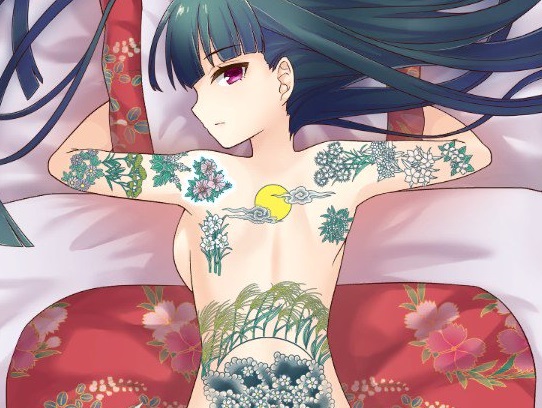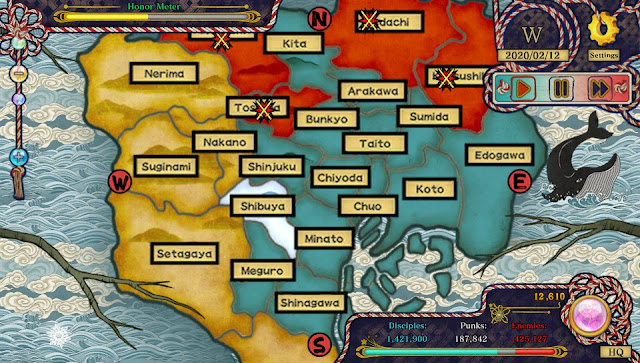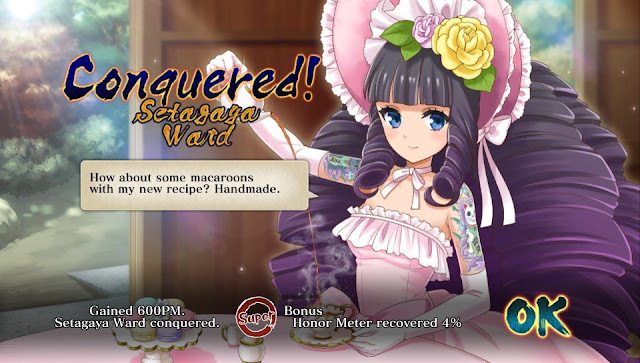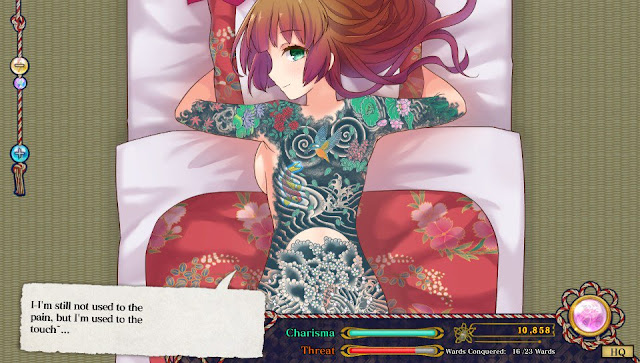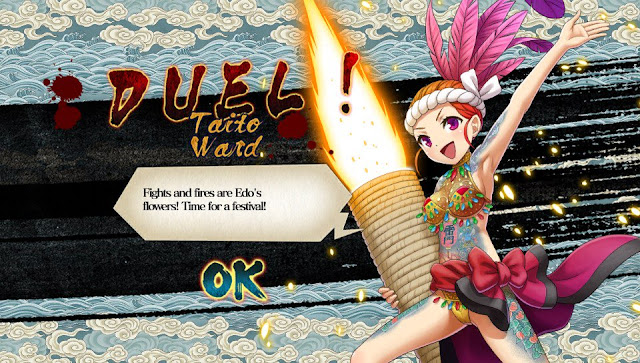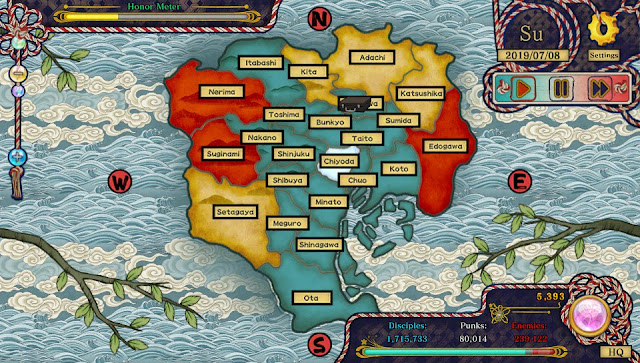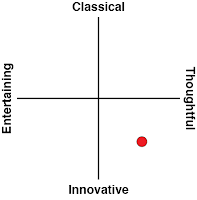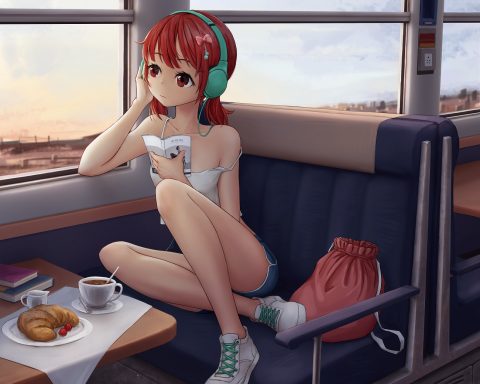Review by Matt S.
Tokyo Tattoo Girls is, tonally, one of the oddest games that you’ll ever play. From a quick glance you’d be forgiven for thinking that it’s a standard fanservice-heavy JRPG. This is particularly true since NISA, which counts JRPGs as its bread and butter, is the one that is publishing it in the west, and the promotional material make it look like just that – some kind of weird JRPG that’s all about plastering cute anime girls with tattoos.
Related reading: The closest comparison to Tokyo Tattoo Girls that we can think of is Plague Inc. Which shares the approach to strategy, but lacks the girls. Matt’s review.
The game is nothing like that at all. It’s actually something far more interesting, original and creative than that (even though you are indeed plastering cute anime girls with tattoos). Tokyo Tattoo Girls is a grungy casual strategy game. You read that right – it’s like what would happen if you took Plague Inc, and threw some Goichi Suda input into the mix. In fact, I wouldn’t be surprised if the development team has graduates from Goichi Suda’s Grasshopper Manufacture within the creative outfit. It feels something something Suda-san would do and approve of.
And that, in turn, means it’s something I approve of.
Before I start the review, though, a digression: having just written the above paragraphs, I decided to go and do some research on this game’s developer: Sushi Typhoon. What I discovered was gold. Sushi Typhoon is a label that was set up by Japanese media giant, Nikkatsu, as a specialist brand for low-budget exploitation, horror and sci-fi films. It stopped producing films in 2012, but of the seven released under the label, the brand drew the involvement of directorial talent including Takashi Miike and Sion Sono.
So it’s no wonder I have found myself to be quite enamoured to Tokyo Tattoo Girls. It’s coming from a similar creative place as Sion Sono, my favourite filmmaker of all time, and, funnily enough, both this game and Sion Sono come from similar places. I find the way Sion deconstructs and plays with the B-grade yakuza genre to be his most fascinating work. Why Don’t You Play In Hell and Tokyo Tribe are works of visionary cinema, as far as I’m concerned, and Tokyo Tattoo Girls does a surprisingly similar thing to what Sion does in his films within the boundaries of a videogame.
Yep, that’s right; yakuza. It might not look anything like SEGA’s big JRPG franchise about Japan’s both oddball and terrifying organised crime community, but Tokyo Tattoo Girls is every bit as much of a yakuza game. It’s just that it’s oddly subtle and culturally-specific about it: it’s a game that won’t seem like it’s about the yakuza to people less familiar with the legends, stories, and reality of the real world mobsters.
Take the central motif of the tattoos, for example. We don’t generally think much about tattoos out west, but in Japan there’s still a significant stigma around them, because for the longest time tattoos meant yakuza. You had one, you were one in the eyes of most people in decent society, and that was the end of your change to be taken seriously in non-criminal circles in Japan. It’s an attitude that’s fading because modern kids love their tattoos, but to this day, if you’ve got a tattoo, then you’ll be denied entry into any number of hot springs and resorts throughout Japan if you’re not able to cover it up.
So within the context of Tokyo Tattoo Girls, the fact your role in the game is as a tattoo artist covering these girls with ink is not just a weird bit of fetish fanservice, as some might interpret it to be. It actually represents a subversive, deeply underground part of Japanese culture that is very much like the western underground punk or grunge movements; the deliberate appropriation of symbols and things that “decent” people find distasteful for the purposes of their art. Sushi Typhoon has players give power to their characters by embracing these underground movements and providing tattoos for the girls, which really talks up the game’s transgressive spirit. It’s so important to the game’s thematic core, which is why it’s also so incredibly impressive that the team recruited a genuinely famous Japanese tattoo artist, Koji Tanaka (he has worked on The Fast and The Furious: Tokyo Drift, and other films that required traditional Japanese tattoo art), to ensure that all the ink designs and colours are properly authentic and fit with the theme. I almost wish I was playing the PC version of this game instead of on my relatively small Vita screen, so I could fully appreciate in the incredibly detailed art and designs that you can ink onto each girl’s back.
Those tattoos – and much of the game’s art in general – is also strongly reminiscent of ukiyo-e art in terms of visual design. Ukiyo-e is one of Japanese most treasured contributions to the art world, and whether people know it by name or not, most would recognise the distinctive art of woodblock prints if they saw it. There’s nothing inherently underground about it, of course. The Great Wave of Kanagawa, the iconic art work by Hokusai, is an example of ukiyo-e, and it’s as non-controversial as the Mona Lisa, as far as art goes. But ukiyo-e is also used for the visual art found on Hanafuda cards. Hanafuda is a card game of chance that, historically, has had the same connections to the yakuza that poker had with the mafia. The only difference being that those associations between the yakuza and Hanafuda have persisted on far longer – even a generation or two ago there were people that would not allow their kids to learn Hanafuda because of those associations with yakuza.
In the context of a game about gangs vying for dominance over Tokyo, the ukiyo-e aesthetics resemble more the Hanafuda of old than The Great Wave and the great respect the mainstream art community has for the ukiyo-e art style in general. It is, again, underground and grungy, and the game simply wouldn’t be the same depth of cultural impact were a more realist – or even modern anime – direction taken. Tokyo Tattoo Girls is undeniably beautiful to look at, but at the same time in contrast to the “high art” approach to ukiyo-e in games like Okami and Oreshika, this one has a edgier, or seedier tone to it. I mean that as seedy in a good way – it’s bold, and stark, and the way it’s used reinforces the game’s B-exploitation themes. And that, too, fits with a separate ukiyo-e tradition, quite aside from both Hanafuda and the Great Wave. At a point even before the yakuza, ukiyo-e was the art style of choice to depict brothels and other underground nighttime activities. It was an erotic art style, too, and that’s why it works so well when used as the basis for tattoo art.
The only disappointment to the art is the characters themselves are rendered with a modern anime aesthetic. There’s no clash between these characters and the ukiyo-e approach to the tattoos and the game’s map, but it does hurt the consistency of the game somewhat to have these two very different art styles sitting on top of one another. But then, the way women are depicted in ukiyo-e would not longer be considered attractive and sexy by modern standards, and the spirit of ukiyo-e requires that the women be seen as beautiful, so in a way the game’s aesthetics are still keeping to theme, even as they break with tradition.
Further reinforcing the underground themes of the game are the characters themselves. The game (and I’ll get onto the gameplay soon, I promise) divides Tokyo into 23 wards, and tasks you, in that role of tattoo artist to one of six characters, to take control of the wards away from the boss of each. This is something only people who have been to Tokyo can really understand, but within real-world Tokyo, each district genuinely has its own subcultures, and you really can almost draw hard borders between them. The anime otaku go to one place, the aspiring pop stars another, and the train fans a third place. Fashionistas go one place, while one suburb across you’re in a poorer where the punks live up to their violent reputations. And, again, there are hard lines between them that rarely cross. In Tokyo Tattoo Girls, each ward’s leader represents that real-world area’s dominant subculture… once again reinforcing that this game is playing heavily on the underground heartbeat and clannish nature of Tokyo city life (something Sion Sono himself deconstructed so beautifully in Tokyo Tribe).
All of the above comes together to give Tokyo Tattoo Girls the most unique tone and atmosphere in a game I’ve played all year. And that’s amazing considering it’s a game where 90 per cent of the time is split between looking at a map, and looking at the lithe bare back of a beautiful woman. It must have been a struggle for NISA to figure out an angle to market this one, and indeed I went into the game not really knowing what to expect. Based on the pre-release materials I actually thought this was going to be some kind of strategy JRPG – I was expecting something like Eiyuu Senki, truth be told – so it took me a while to resolve what this game was actually about within myself and get comfortable with it. But after a couple of hours I really fell into the rhythm of it, and it has become one of those rare games that I found myself staying up until 3 or 4am to play a little longer, consequences and a need to overdose on coffee the next day be damned.
Tokyo Tattoo Girls is a casual strategy game, and as I alluded to at the start, the best comparison I can think of is to compare it to Plague Inc. In the game, you can’t actually directly order troops around; they’ll do their thing by themselves, while you watch the action unfold on the main map. What you can do is issue commands from a menu, which will affect how effectively your soldiers do their job. So, for example, the only way to get a “game over” in the game is to run out of “honor.” Every time your units invade a ward, until they’ve completely conquered the ward there’s a risk that the battle between the gangs will turn into civil unrest, which results in damage to your honor rating. You can use your character’s influence via the menu to calm at-risk areas down, or to focus recruitment of new soldiers on your side into a specific ward, hoping to capture it more quickly.
Commands cost money (protection money, or PM) to enact. The problem is that it also costs PM to tattoo your girl’s body, and those tattoos have a significant impact on the overall success of your armies, so the other key strategic consideration in Tokyo Tattoo Girls is how to split the spending between issuing commands, and getting tattoos done. There’s a rhythm to it, and as the game really heats up, it’s very easy to get a few beats wrong and suddenly be facing defeat. On any difficulty setting above “easy” the game is incredibly unforgiving, but thankfully games are over in an hour or two at most, so it’s not a major time commitment if you find yourself in an unwinnable position and need to restart.
The game seems complex at first, but as there are only a dozen or so different commands to choose between, it doesn’t take long to get a hang of the game’s basics. From there, it’s simply a matter of how effective you are tactically that will determine whether you’re successful or fail. Tokyo Tattoo Girls is let down by a really poor tutorial which doesn’t clue you into the game much more than if you didn’t read it. It’s further let down by an interface that, while beautiful, doesn’t do a good job in displaying critical information, such as how close you are to capturing a specific ward at any time. You get a general announcement that you’re “close”, but to actually drill down and see specific numbers you’re going to need to wade through a very clumsy interface. Despite these issues I found it only took me two games to really start to understand how to effectively manage the game’s competing strategic challenges, and once I had a basic understanding there the game flowed well thereafter.
Fanservice is always a tricky beast in games, and Tokyo Tattoo Girls has a lot of it – not only to you see the gorgeous bare backs of the lovely girls that you’re tattooing (and just the edge of their boobs to remind you that they are indeed very naked women right there), but if you do a particularly good job of capturing a ward, you’re gifted with a special gallery image of the leader of that ward, often posed in a fanservicey (but not naked) position. The tattooing itself isn’t presented as overly sexualised, though the girls do moan a little and make comments about how much they like the pain or your touch as the tattoo artist, and in fairness it is presented as a little exploitative, since you don’t actually see the impact of the tattoos. They just help boost your numbers crunching away in the game’s spreadsheets in the background. It would have been easy to replace this mechanic with almost anything and have the same effect. For instance, you could have been buying flowers, and each flower could have had the same effect the tattoos did; providing the girl with slowly growing power-ups. You could have done that and she would never have needed to bear her back to you.
On the other hand, thematically, as I’ve discussed above, the tattooing, the ukiyo-e style of the art itself, and the general narrative of the game makes the yakuza associations – and associations with B-grade yakuza cinema – quite necessary. Tonally the game would lose a lot without those tattoo scenes. The gallery images on the other hand are quite unnecessary, and don’t really add anything to the game’s theme, but they’re also very minor asides, and for the most part I would argue that this is one fanservicey game that absolutely needs that fanservice for the kind of experience that it’s creating.
There’s no question that Tokyo Tattoo Girls is a very, very niche game. I’m genuinely surprised NISA even decided to localise and publish it, because the entire premise of the game relies on artistic, narrative, and cultural themes that are only vaguely known or understood in the west, if at all. That being said, I am so glad that I got to play the game. It isn’t what I was expecting, and initially it was confounding, but the more time I spent with it, the more I came to love it for its grungy underground spirit. Hopefully Sushi Typhoon has more success as a game development and publishing label than it did as a film brand, because on the strength of these early projects (it has a horror game, localised by Aksys, just released on 3DS too), this is a developer with a fascinatingly alternative creative vision, and is probably as close to getting Sion Sono to make a game as we’ll get.
– Matt S.
Editor-in-Chief
Find me on Twitter: @digitallydownld
 |
| Please Support Me On Patreon!
|


